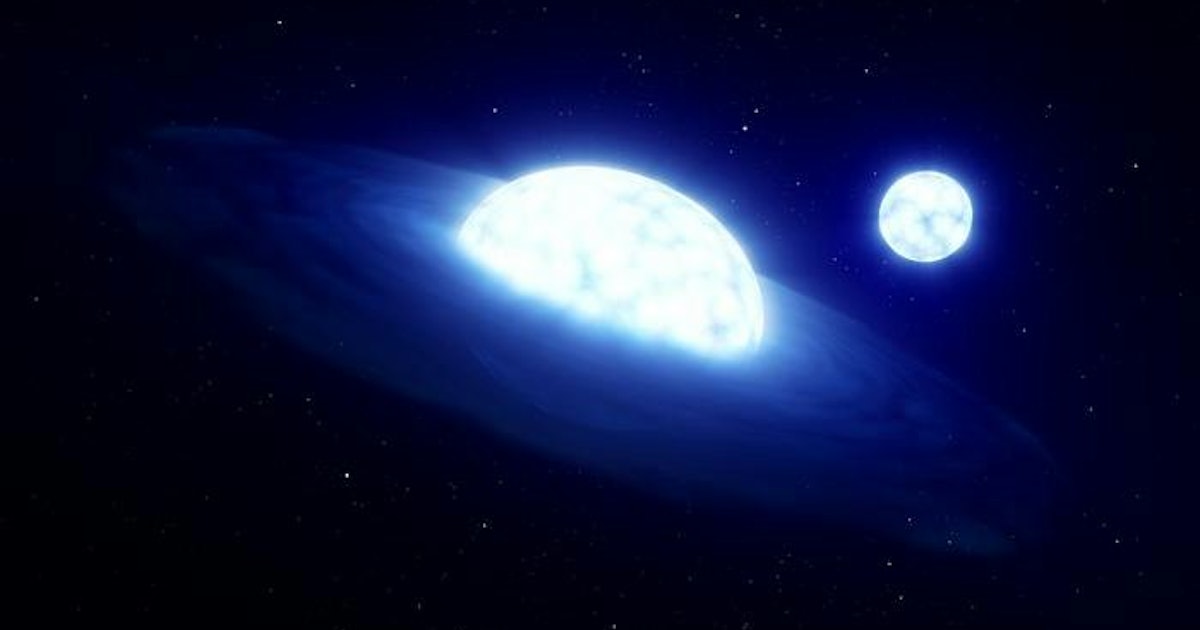
Stellar-Sucking Vampire Stars May Thrive in Groups of Three
Some stars (like our sun) prefer to live alone, while many others tend to live in pairs. Then, there are “vampire stars.” Unlike more well-behaved and stable cosmic pairs, these stars instead siphon the atmospheres off their stellar companions, and now new evidence suggests they might actually thrive in triple star systems.
Scientists at the University of Leeds in the U.K. discovered this potential breakthrough using data from the European Space Agency’s (ESA) Gaia satellite, which has surveyed almost two billion celestial objects during its past decade in space. Their research was published Monday in the journal Monthly Notices of the Royal Astronomical Society.
The horror-inspired nickname pretty accurately describes “Be stars,” a type of star that spins very fast and sports a belt of material around itself known as a circumstellar disk. They’re a subset of B stars, which are hot, bright, blue-white in color, several times larger than the Sun, and usually accompanied by at least another star. By analyzing these systems, astronomers and astrophysicists hope to find clues about how stars can diverge in their evolution and also how black holes form when these types of stars die.
But arguably, the most peculiar aspect of Be stars is that they devour the atmospheres of their stellar companion — much like a gargantuan, star-sucking Dracula. Then, Be stars collect this material in their mid-sections in a gaseous disk similar to Saturn’s rings.
Three’s Company
To learn more about what’s going on in these environments, scientists from the University of Leeds looked at data on how the B stars and Be stars moved in the night sky over short periods of six months as well as longer periods of about a decade.
“If a star moves in a straight line, we know there’s just one star, but if there is more than one, we will see a slight wobble or, in the best case, a spiral,” Jonathan Dodd, Ph.D student and researcher, said in a University of Leeds statement published Monday.
This analysis yielded an unexpected result that showed fewer companion-star signatures for Be stars than for B stars. But the vampire Be stars must get their disks of gas somehow, so the team looked at a different set of data.
This time, they looked for companion stars that might be further away from the Be and B stars. This provided the missing Be victims/companions, but something else, too.
Be stars might have a third star that acts like a kind of vampire familiar. The third stars, according to the team, might play a role in forcing the companion star closer to the voracious Be star. Once they’ve been whittled down in size, the companions may be too faint to be detected, which explains their near absence in the first set of data.
The More the Merrier
More than half the stars in the sky have a partner, which means studying our Solar System isn’t enough to truly comprehend the complexity of star formation.
Lead researcher René Oudmaijer says in the statement that over the last decade, astronomers have realized binarity is “an incredibly important element in stellar evolution,” but now, “we are now moving more towards the idea [that] it is even more complex than that and that triple stars need to be considered…triples have become the new binaries.”
Thankfully surveys like Gaia, as well as other ground-based telescopes, continue to survey billions of points in the visible night sky to track these changes. Just last year, astronomers discovered that the nearest black hole to Earth — HR 6819 — wasn’t actually a black hole at all but instead a similar vampiric star system. You just never know where these mysterious, stellar-sucking vampires may be lurking.
Some stars (like our sun) prefer to live alone, while many others tend to live in pairs. Then, there are “vampire stars.” Unlike more well-behaved and stable cosmic pairs, these stars instead siphon the atmospheres off their stellar companions, and now new evidence suggests they might actually thrive in triple star systems. Scientists at the…
Some stars (like our sun) prefer to live alone, while many others tend to live in pairs. Then, there are “vampire stars.” Unlike more well-behaved and stable cosmic pairs, these stars instead siphon the atmospheres off their stellar companions, and now new evidence suggests they might actually thrive in triple star systems. Scientists at the…